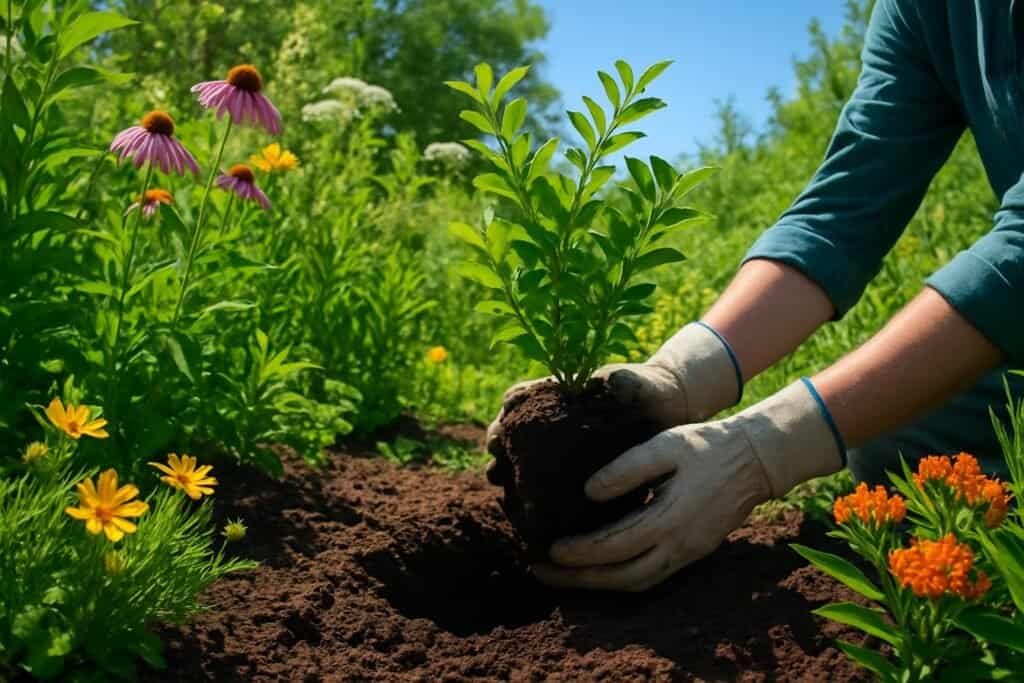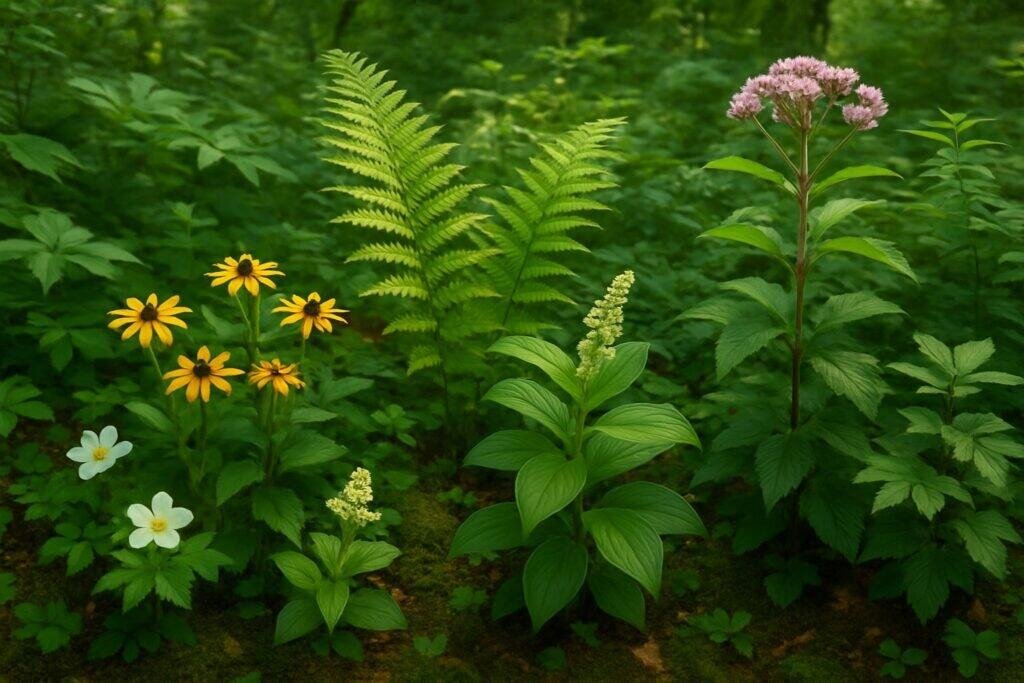Native plants grow naturally in your local area. They have evolved over thousands of years alongside local wildlife and climate conditions.
These plants connect deeply to their environments. They offer numerous benefits compared to non-native species.
Planting native species in your garden supports local ecosystems. Birds, butterflies, and other wildlife depend on these plants for food and habitat.
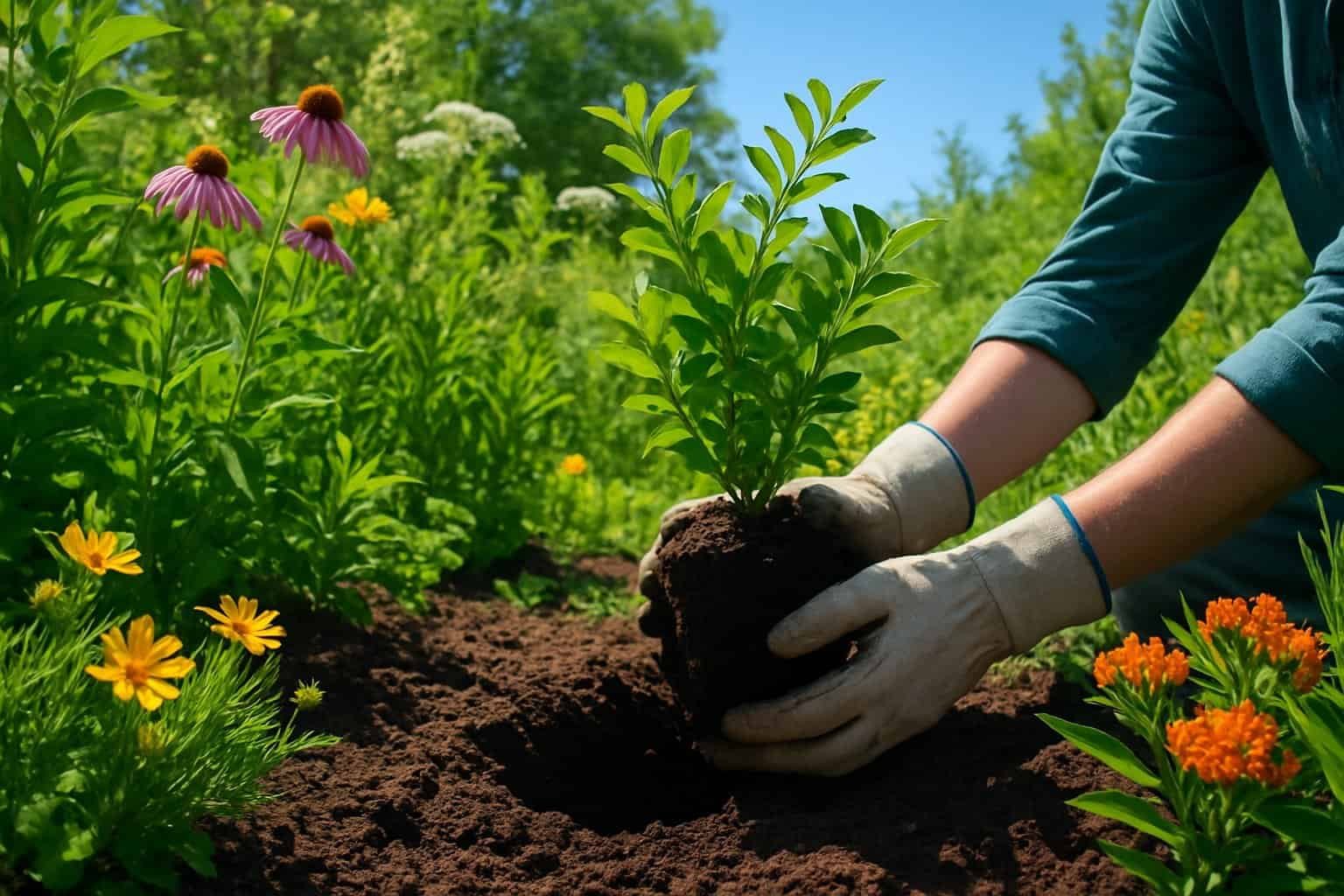
When you choose native plants, you make a practical decision for your garden. These plants usually need less water, fertilizer, and maintenance because they’re already adapted to local soil and weather.
You’ll spend less time and money caring for your garden. At the same time, you can enjoy beautiful, thriving plants.
Key Takeaways
- Native plants support local wildlife by providing essential food sources and habitat for pollinators and birds.
- Gardens with native species require less water, fertilizer, and overall maintenance than those with non-native plants.
- Incorporating native plants helps preserve biodiversity and strengthens the resilience of local ecosystems.
What Are Native Plants?
Native plants are species that have evolved in a specific region over thousands of years. They form important relationships with local wildlife and adapt to environmental conditions.
These plants play crucial roles in ecosystem health and biodiversity.
Definition and Characteristics
Native plants occur naturally in a particular region, ecosystem, or habitat without human introduction. They have evolved over thousands of years alongside local wildlife, soil microbes, and climate.
These plants have specific adaptations that help them thrive in their native environments. Once established, they typically need less water, fertilizer, and maintenance than non-native species.
Native plants form complex relationships with local pollinators, birds, and other wildlife. They provide essential food sources and habitat that non-native plants often cannot offer.
Their flowering, fruiting, and seed production match the needs of local wildlife and seasonal patterns.
Difference Between Native and Non-Native Species
Native plants evolved locally. Non-native (or exotic) plants came from other regions or countries and lack the evolutionary history with local ecosystems.
Some non-native plants become invasive and outcompete native species for resources. They often spread aggressively because they lack natural predators or diseases.
Native plants support much more biodiversity. For example, native oak trees can support over 500 species of caterpillars, while non-native ginkgo trees support only 5 species.
Non-native plants often need more water, fertilizer, and pest control to survive. This makes them less sustainable and more resource-intensive.
Examples of Regional Native Plants
Northeast: Eastern redbud, black-eyed Susan, purple coneflower, and various oak species thrive here. These plants handle cold winters and support local wildlife like chickadees and monarch butterflies.
Southeast: Southern magnolia, Carolina jessamine, and bald cypress suit humid conditions. They provide habitat for many bird species and survive occasional flooding.
Midwest: Prairie plants like big bluestem grass, compass plant, and purple prairie clover have deep roots. These roots help them survive drought and build healthy soil.
West Coast: California poppy, manzanita, and Douglas fir do well in Mediterranean or coastal climates. These plants often need little irrigation once established.
Benefits of Planting Native Plants
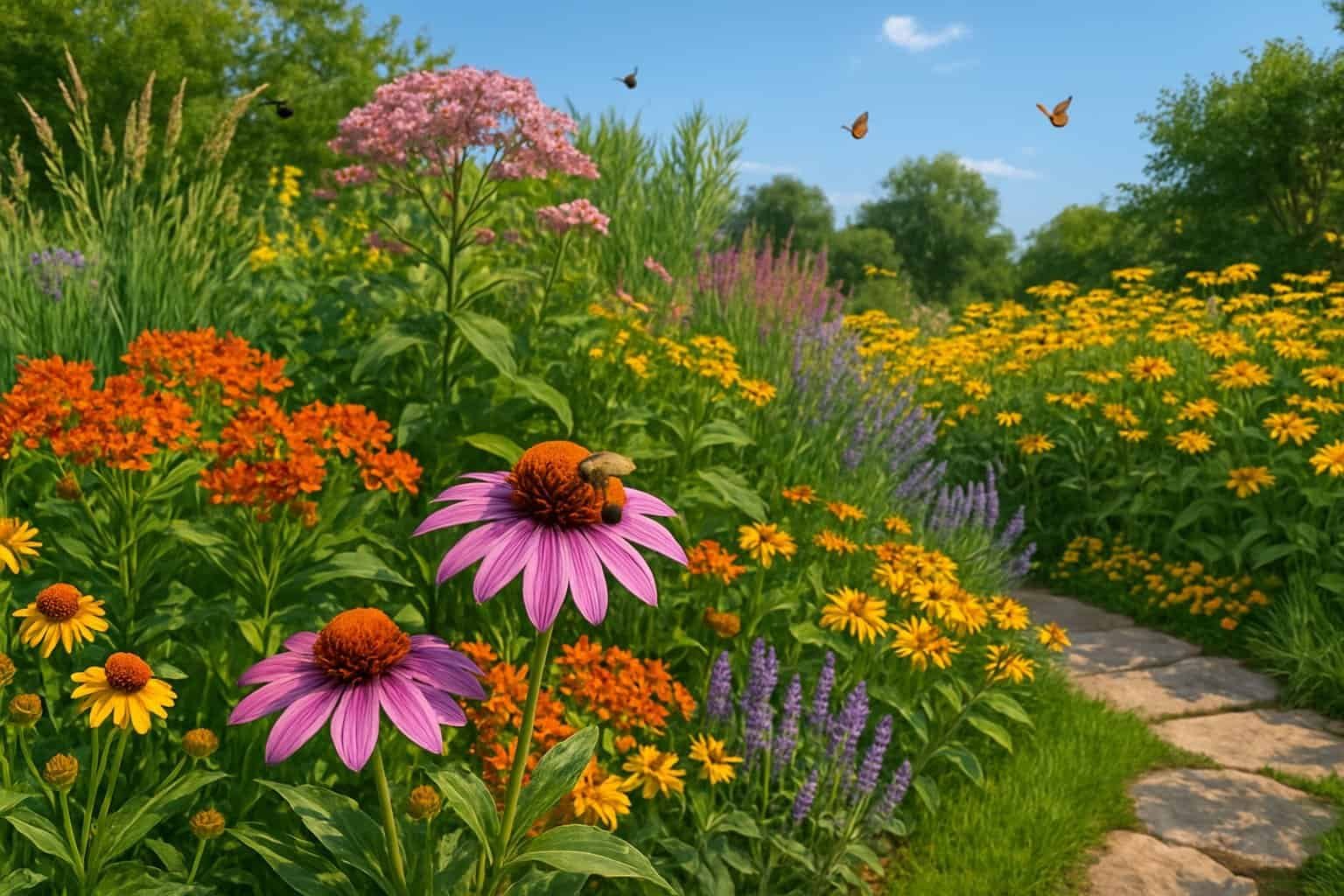
Native plants offer practical advantages for any garden. They provide ecological benefits, need less care, and add natural beauty to landscapes.
Ecological Advantages
Native plants support local wildlife by providing food and shelter. Birds, butterflies, and bees rely on these plants.
Research shows native oak trees support over 500 species of caterpillars. Non-native alternatives may support fewer than 5 species.
Their deep root systems prevent erosion and filter water pollutants. During heavy rains, native plant gardens absorb 30% more water than typical lawns.
Native plants don’t need fertilizers or pesticides to thrive. This reduces harmful chemicals that can run into waterways.
A garden with native plants creates a mini-ecosystem that regulates itself naturally.
Low Maintenance Landscaping
Once established, native plants require minimal care. They’ve adapted to local climate conditions over thousands of years.
This means less watering, fertilizing, and maintenance. Native plant gardens typically need 70% less water than conventional landscapes, saving money and resources.
Local plants have natural defenses against regional pests and diseases. This reduces the need for chemical treatments.
Most native landscapes need only seasonal attention rather than weekly care. Homeowners report spending about 75% less time maintaining native gardens compared to traditional ones.
Aesthetic Value and Natural Beauty
Native plants create landscapes with year-round visual interest. They offer changing colors and textures through the seasons.
Spring wildflowers, summer blooms, fall colors, and winter textures keep gardens looking dynamic. These plants come in endless varieties, from tall prairie grasses to delicate woodland flowers.
Native plant gardens can be formal or casual depending on design and plant selection. They connect people to regional identity and heritage by showcasing the unique botanical character of an area.
Many native plants feature spectacular blooms and interesting forms. Black-eyed Susans, purple coneflowers, and cardinal flowers add vibrant colors with minimal care.
Supporting Local Ecosystems and Biodiversity
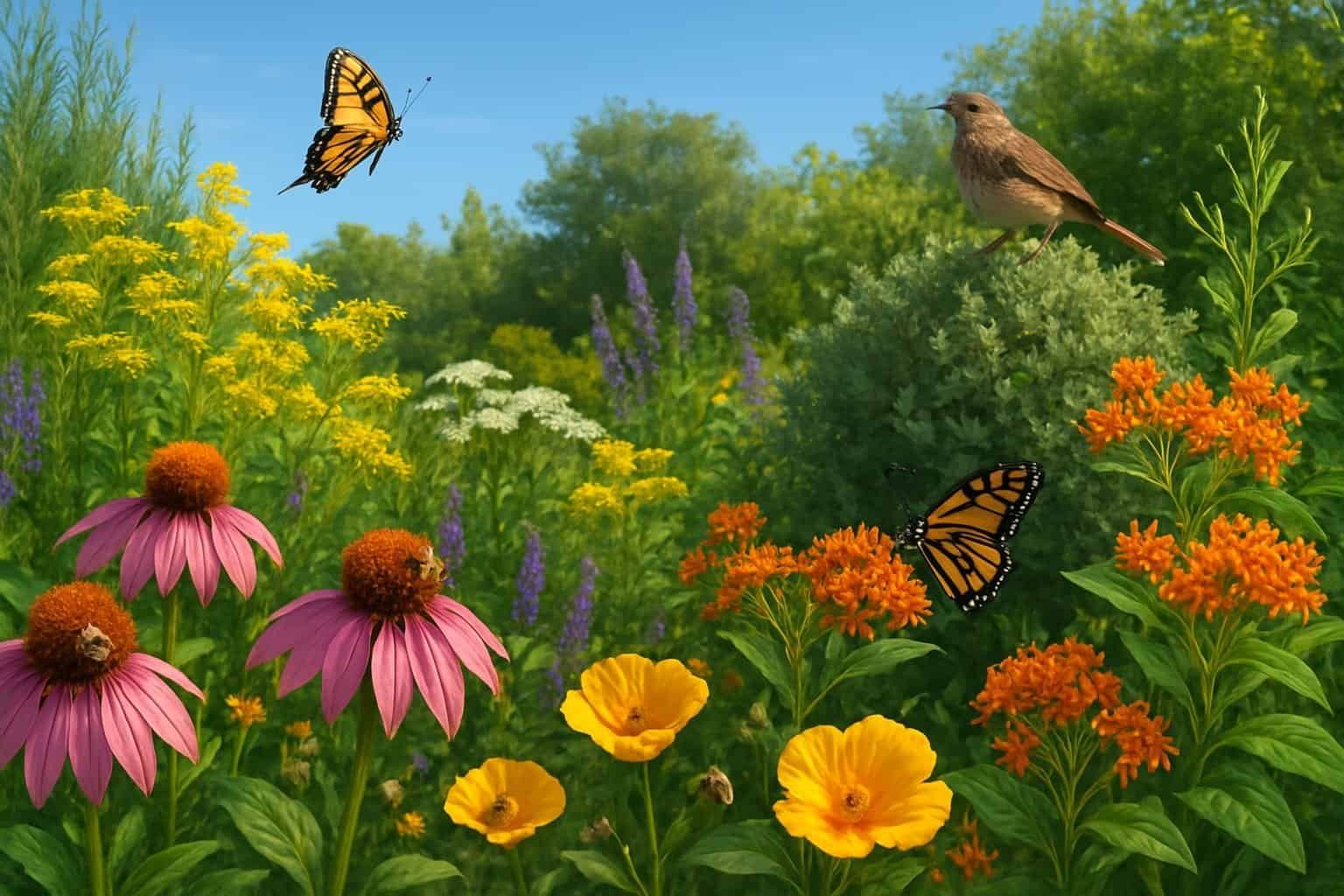
Native plants form the foundation of healthy local ecosystems. They have evolved alongside local wildlife for thousands of years.
These relationships support the entire web of life in your region.
Enhancing Wildlife Habitat
Native plants provide ideal shelter and food for local wildlife. Birds, butterflies, and bees depend on specific native plants.
For example, native oak trees support over 500 species of caterpillars. Non-native trees might host fewer than 10 species.
These caterpillars become food for birds and other animals. Native plants offer the right nutrition at the right times.
They produce nectar, berries, nuts, and seeds when local wildlife needs them most. The physical structure of native plants also matters.
Some birds only nest in certain native trees. Small mammals might shelter in specific native grasses.
Even dead native plants help wildlife. Hollow stems provide homes for beneficial insects during winter.
Preserving Food Webs
Food webs show how energy moves through an ecosystem. Native plants sit at the base of these networks.
Native insects evolved to eat specific native plants. Many insects cannot eat non-native plants.
When native plants disappear, the insects that depend on them also vanish. This creates a domino effect through the food web.
Example of a Simple Food Web:
- Native plants → Native insects → Birds → Predators
- Remove native plants → Fewer insects → Fewer birds → Ecosystem imbalance
Native plant seeds and fruits ripen when local wildlife needs them. This timing developed over thousands of years.
Many soil organisms also depend on relationships with specific native plant roots.
Promoting Biodiversity
Biodiversity means having many different types of plants and animals in an ecosystem. Native plants boost biodiversity at all levels.
A yard with diverse native plants can support 4-5 times more bird and butterfly species than one with only non-native plants.
Even small native plantings help create habitat corridors that connect larger natural areas. These corridors allow wildlife to move safely between habitats.
Native plant communities improve soil health by supporting diverse microorganisms underground. Different native plants help wildlife at different life stages.
For example, monarch butterflies need milkweed for caterpillars and native flowers for adult feeding. Diverse native plant communities create resilient ecosystems that can better adapt to changing conditions.
Attracting and Sustaining Pollinators
Native plants and pollinators have evolved together over thousands of years. These relationships benefit both the plants and the wildlife.
Pollinator-Friendly Features
Native plants offer features that make them ideal for local pollinators. Their flower shapes, colors, and blooming times match the needs of native insects.
Many have landing platforms sized for bees or long tubular flowers for hummingbirds. Clustered plantings of native species create “pollinator corridors” that help insects move safely through landscapes.
These pathways are especially important in fragmented habitats. Unlike many non-native ornamentals bred for looks, native plants still produce abundant nectar and pollen.
Some hybrid plants have lost these food sources for showier blooms. Native plants also tend to bloom in sequence, providing a continuous food supply for pollinators.
Supporting Native Bees and Butterflies
Native bees rely on specific native plants for survival. Many native bees are specialists that can only gather pollen from certain plant families.
Mason bees, mining bees, and bumblebees often emerge early in spring when only native plants are flowering. Without these early bloomers, these pollinators would starve.
Butterflies need two types of native plants: nectar sources for adults and host plants for caterpillars. Monarch butterflies, for example, can only lay eggs on milkweed.
A true butterfly garden includes both food sources. Black-eyed Susans and coneflowers provide nectar, while oak trees and native grasses support many caterpillar species.
Even small native plantings attract many pollinators. Research shows that urban yards with native plants support 8 times more native bees than conventional landscapes.
Role of Nectar and Pollen
Nectar provides carbohydrates for energy. Pollen supplies protein and fats for pollinators.
These nutrients are essential for insect growth, reproduction, and survival. Native plants usually produce higher quality nectar than non-native alternatives.
This food helps pollinators resist diseases and environmental stress. The timing of nectar and pollen release in native plants matches the life cycles of local insects.
When native bees emerge, their preferred native flowers are ready with food. Plants like goldenrod and asters provide crucial late-season resources when other food sources disappear.
These fall bloomers help insects prepare for winter or migration. Pollen from native plants often contains compounds that help pollinators fight parasites and infections.
Conservation and Environmental Impact
Native plants provide significant benefits for the environment. They help protect natural resources, reduce harmful chemicals, and combat both climate change and invasive species threats.
Reducing Pesticides and Fertilizers
Native plants naturally resist local pests and diseases because they evolved alongside them. This natural resistance means gardens with native plants need fewer pesticides or sometimes none at all.
Chemical pesticides harm beneficial insects like bees and butterflies. When these chemicals wash into streams and lakes, they damage aquatic ecosystems.
Native plants also thrive without added fertilizers. They’ve adapted to local soil and don’t need extra nutrients that non-native plants often require.
Reducing chemical inputs saves money and time on garden maintenance. It also prevents fertilizer runoff that causes algae blooms in waterways.
Mitigating Climate Change
Native plants help fight climate change in several important ways. Their deep root systems capture carbon dioxide from the atmosphere and store it underground for long periods.
These root networks also prevent soil erosion during heavy rains or floods. Climate change has made these events more common.
Many native trees and shrubs provide shade that reduces cooling needs in summer. This cuts energy use and related carbon emissions.
Native plant landscapes need less maintenance with power equipment. Fewer mowings mean reduced fossil fuel consumption and lower greenhouse gas emissions.
Water conservation is another benefit. Native plants usually need less irrigation than non-natives, reducing the energy needed to pump and treat water.
Controlling Invasive Species
Invasive plants threaten biodiversity by outcompeting native species for resources. They often spread rapidly because they lack natural predators or diseases to control them.
Planting natives helps restore ecological balance. Native plants create habitat for local wildlife that may help control invasive plant populations naturally.
Some invasive plants release chemicals that prevent other plants from growing nearby. Native plants have evolved defenses against these tactics.
Warning signs of invasive plants:
- Extremely rapid growth
- Spread aggressively through seeds or roots
- Few or no natural pests
- Outcompete other plants quickly
Removing invasive species and replacing them with natives helps restore damaged ecosystems. This effort supports wildlife that depends on native plants for food and shelter.
Improving Soil Health and Water Conservation
Native plants play a vital role in maintaining healthy soil ecosystems while reducing water usage. Their natural adaptations make them powerful allies in conserving water and building soil resilience.
Deep Root Systems and Soil Stability
Native plants typically develop deep root systems that reach farther than non-native ornamentals. These roots can extend several feet into the soil, creating pathways for water and air to penetrate hard ground.
Prairie grasses like Big Bluestem can grow roots up to 12 feet deep. These roots hold soil firmly in place during heavy rains or flooding.
Deep roots contribute to carbon sequestration by storing carbon compounds underground for decades. As roots die back and decompose, they add organic matter to the soil, improving its structure and fertility.
In urban areas, native plants with strong root systems help stabilize soil where development has disturbed natural ground cover. This reduces maintenance costs and prevents property damage from shifting soils.
Conserving Water and Reducing Runoff
Native plants require much less supplemental watering once established. They evolved in local rainfall patterns and can thrive without irrigation in most years.
Gardens with native plants use up to 80% less water than conventional landscapes. This conservation is especially important in drought-prone regions with water restrictions.
The deep, fibrous root systems of native plants create a sponge-like effect in soil. During heavy rains, these plant communities:
- Slow water movement across the landscape
- Increase ground absorption rates
- Filter pollutants from water
- Reduce flooding in downstream areas
Rain gardens with native wetland plants can capture and clean stormwater from roofs and driveways. These systems help recharge groundwater supplies instead of sending runoff to storm drains.
Enhancing Local Growing Conditions
Native plants improve soil structure through relationships with beneficial microorganisms. Many form partnerships with mycorrhizal fungi, which extend the plant’s reach for nutrients and water.
These plant-microbe relationships build soil health over time. The improved soil structure:
- Holds more moisture during dry periods
- Drains properly during wet weather
- Contains balanced nutrients for plant growth
- Supports diverse soil life forms
Leaf litter and debris from native plants create a protective mulch layer. This covering regulates soil temperature and prevents moisture loss through evaporation.
Native plant communities adapt to specific local conditions like clay soils, sandy areas, or alkaline environments. They thrive in these spots without needing soil amendments or chemical treatments.
How to Start Planting Native Plants
Starting a native plant garden begins with understanding your local ecosystem. Planning, proper selection, and thoughtful design create a landscape that supports local wildlife while reducing maintenance needs.
Selecting the Right Species
Native plants thrive in your local climate because they’ve adapted to the conditions over thousands of years. Start by identifying your region’s plant hardiness zone and soil type.
Consider the growing conditions of your space. Is it sunny or shady? Wet or dry?
Each native plant has specific requirements. For example, butterfly weed prefers full sun and well-drained soil, while woodland phlox thrives in partial shade.
Match plants to your yard’s conditions instead of changing your yard to fit specific plants. This approach leads to better success and less maintenance.
Native trees provide the greatest ecological benefit. A single oak tree can support hundreds of insect species, which in turn feed birds and other wildlife.
Sources for Native Seeds and Plants
Several reliable sources offer native plants and seeds. Local native plant nurseries specialize in regional species and often provide valuable advice about planting and care.
Recommended Sources:
- Native plant societies
- Conservation district plant sales
- Botanical gardens
- Wild Ones chapter plant exchanges
- Reputable online native plant nurseries
When purchasing, confirm plants are truly native to your region, not just North America. Ask if plants were grown without neonicotinoid pesticides, which can harm pollinators.
Seeds offer a cost-effective way to establish larger areas. Many native seeds need cold stratification (exposure to winter conditions) before germinating, so fall planting often works best.
Designing a Native Plant Garden
Effective native plant gardens balance ecological function with visual appeal. Group plants in natural-looking clusters instead of single specimens.
Consider bloom times to ensure year-round interest. Early spring woodland flowers, summer prairie plants, and fall-blooming asters provide continuous color and resources for wildlife.
Basic Design Principles:
- Plant in layers (trees, shrubs, perennials, groundcovers)
- Group plants with similar water needs together
- Include a mix of flowering and non-flowering plants
- Leave some bare soil for ground-nesting bees
Start small with a manageable area, such as replacing a section of lawn or creating a small rain garden. Success with a small space builds confidence for larger projects.
Native plant gardens look different from traditional landscapes. They may appear “messy” to some but provide crucial habitat for wildlife.
Long-Term Resilience and Sustainability
Native plants create robust ecosystems that can withstand environmental challenges while supporting local wildlife and improving air quality. Their benefits extend far beyond their beauty.
Adapting to Local Climate and Conditions
Native plants have evolved over thousands of years to thrive in their specific regions. They require less water, fertilizer, and maintenance than non-native species.
During droughts, native plants often continue to flourish when exotic species struggle. Their deep roots help them access water deep in the soil, increasing their resilience.
These plants also develop natural defenses against local pests and diseases. Homeowners spend less time and money on pest control or replacing dead plants.
In extreme weather events—whether floods, high winds, or temperature swings—native species typically recover faster than non-native alternatives.
Food and Shelter for Wildlife
Native plants provide essential habitat for local wildlife. Birds, butterflies, and beneficial insects rely on specific native plants for food and reproduction.
Many insects can only digest the leaves of plants they evolved alongside. For example, monarch butterfly caterpillars feed exclusively on milkweed plants native to North America.
Wildlife Benefits of Native Plants:
- Berries and seeds provide year-round food sources
- Dense foliage creates nesting sites for birds
- Hollow stems offer winter shelter for beneficial insects
- Flowers provide nectar for pollinators
This wildlife support creates a balanced ecosystem. Birds and predatory insects help manage problem insects naturally.
Contribution to Air Quality and Oxygen Production
Native plants improve local air quality in several ways. Their foliage filters particulate matter from the air, trapping dust and pollutants.
Areas with diverse native plantings have measurably cleaner air than areas dominated by non-native species or concrete. Native trees and shrubs can reduce air pollution by up to 24% in urban areas.
The deep root systems of native plants help sequester carbon dioxide more effectively than many exotic species. This carbon capture helps fight climate change while producing oxygen.
Native plant communities also reduce the “heat island effect” in urban areas. Their cooling properties can lower local temperatures by 2-9°F, reducing energy use for air conditioning.
Frequently Asked Questions
Native plants offer many benefits for gardeners, ecosystems, and wildlife. These plants have evolved over thousands of years to thrive in local conditions and play crucial roles in maintaining healthy environments.
What are the ecological benefits of growing native plants?
Native plants help prevent soil erosion through their deep root systems. These roots hold soil in place during heavy rains and flooding.
They require less water than non-native species once established. This water efficiency helps conserve local water supplies.
Native plants also filter pollutants from water as it moves through soil. This filtering improves water quality in local watersheds and aquifers.
How do native plants contribute to local ecosystems?
Native plants form the foundation of local food webs. They produce seeds, nectar, fruits, and foliage that feed many insect and animal species.
They have co-evolved with local wildlife, creating interdependent relationships. Many native insects can only feed on specific native plants.
Native plant communities also create habitat complexity. Different vegetation layers provide shelter, nesting sites, and protection for various creatures.
What are the advantages of native plants in landscaping?
Native plants usually require less maintenance after establishment. They need minimal fertilizer, pesticides, or supplemental watering compared to exotic species.
They adapt well to local climate conditions and withstand regional weather extremes like drought, floods, or temperature fluctuations.
Native landscapes offer unique regional character and beauty. They reflect the natural heritage of an area instead of creating generic garden styles.
How can planting native species support wildlife?
Native plants provide critical habitat for pollinators like bees, butterflies, and moths. These insects rely on specific native plants for food and reproduction.
Birds depend on native plants for nesting materials, shelter, and food. Native trees and shrubs offer branches for nests and produce fruits and seeds birds eat.
Native vegetation supports diverse insect populations. These insects serve as food for birds, amphibians, and small mammals.
What role do native plants play in human well-being?
Native plant gardens create opportunities for nature connection. These spaces allow people to observe wildlife and natural processes up close.
Interaction with natural environments reduces stress and improves mood. Native gardens can provide these therapeutic benefits at home.
Native plants preserve cultural heritage and history. Many indigenous plants have traditional uses as food, medicine, or materials that connect people to their regional history.
What are the environmental impacts of using non-native plants in gardening?
Some non-native plants become invasive and disrupt ecosystems. Without natural controls, they can spread aggressively and outcompete native species.
Exotic plants often need more resources to grow. Gardeners use additional water, fertilizers, and pesticides, which can harm the environment.
Non-native landscapes support less wildlife. Even non-invasive exotic plants usually attract fewer insects, birds, and other animals than native plants.

